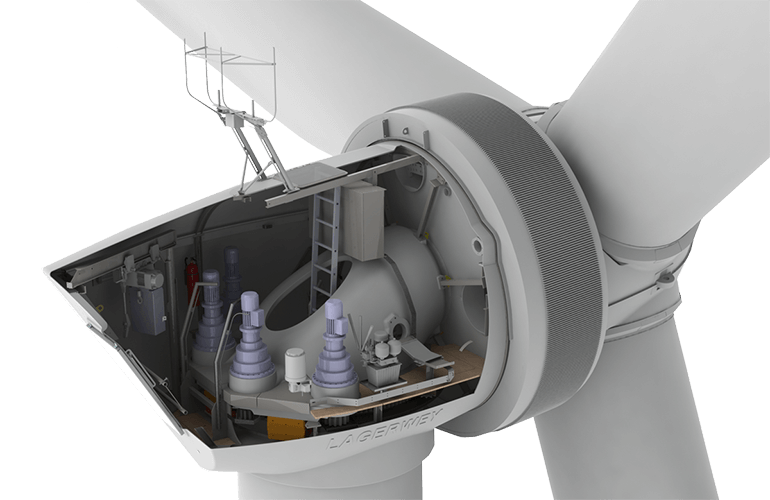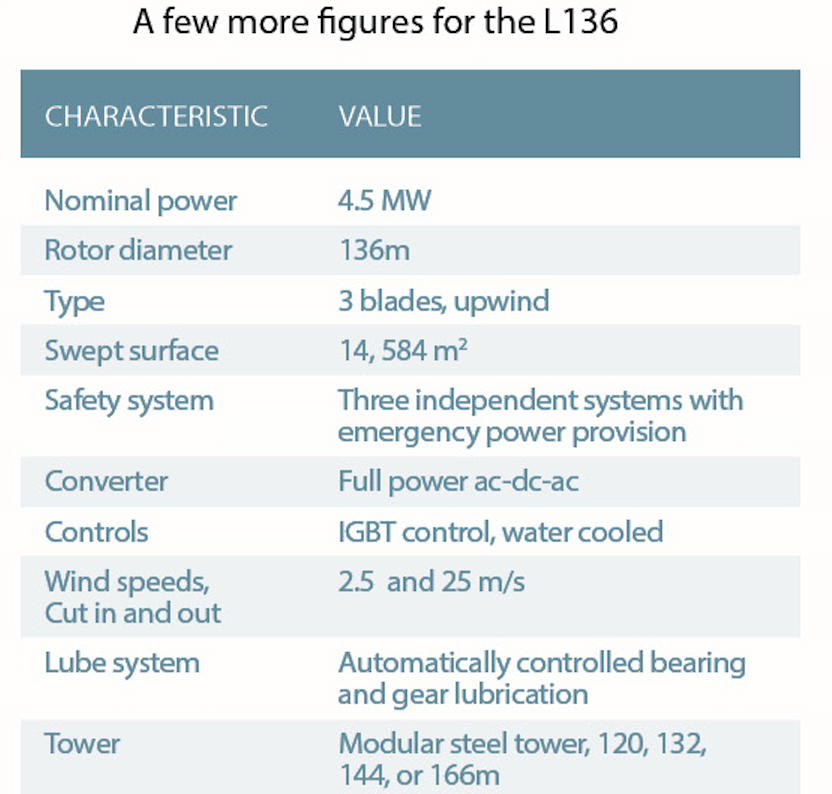By Paul Dvorak, Editor
Windpower Engineering & Development

The cutaway shows a few details in the nacelle.
Most wind-turbine OEMs continually focus on improving the equipment in their nacelles. The engineers at Lagerwey have taken their responsibilities further with a few ideas for a better tower and a clever tower-climbing crane that trims construction and maintenance costs. Unfortunately, the company does not market in the U.S. so you might think its home country of Holland is trying to keep the company a secret.
Let’s change that perception with a “walk-through” that starts in the nacelle. The L136 is a 4.5-MW direct-drive design that sports a permanent-magnet generator so it needs no troublesome gearbox. Generator efficiency hits about 97%, says the company, at full and partial load because there is no need for magnetizing currents and their associated losses. The generator contains few moving parts, so it is said to wear slower than conventional wind-turbine generators.
Another plus for the design: the generator needs no cooling system. The thermal path between the heat source and cooling fins on the outside is as short as possible, so the design uses the natural air flow around the generator to match its cooling needs.
The torque density (an indicator of output per weight, Nm/kg) of the latest generator is higher than conventional direct-drive generators because the magnetic topology uses permanent magnets. This results in a smaller generator diameter with relatively low mass because it needs less active material. The high partial-load performance has an important role in the turbine’s overall energy capture because the turbine spends most of its time in wind speeds that produce less than the rated power.
The company says the design is suitable for sites with high turbulence and significant differences in vertical wind shear. Example locations would be coastal areas with severe wind conditions or inland locations where forests or buildings produce speed differences from the lowest to highest tip height.
The tower is less conventional than the direct-drive generator. It allows heights up to a remarkable 166m. The Modular Steel Tower or MST consists of steel plates assembled at a project site, which can be built higher than conventional towers and at lower costs.
The MST also weighs less than conventional towers, which reduces transport costs. When compared to a concrete tower, shipping costs are cut by 90% according to Lagerwey.
 Furthermore, the 166-m tower transports with little concern for existing infrastructure such as underpasses. (Read about the world’s tallest wind-turbine tower here, and more on a U.S. designed modular tower here.)
Furthermore, the 166-m tower transports with little concern for existing infrastructure such as underpasses. (Read about the world’s tallest wind-turbine tower here, and more on a U.S. designed modular tower here.)
A few other standard features include a service lift, rescue module gondola, and a method for noise reduction. Options include obstruction lights, ice management, and cast-shade regulation.
A clever company-designed crane can climb the tower to install its upper sections, and presumably the nacelle as well. The crane ‘climbs’ on connection points mounted on the MST. Lagerwey says the design simplifies the wind turbine’s installation and allows higher wind turbines at challenging and remote locations where conventional high-lift equipment would be difficult to maneuver.
The Climbing Crane transports on only three standard trailers and without special escort. At the construction site, roads need no reinforcement. Normal requirements for transportation of wind-turbine components are sufficient.
For assembly, the crane needs only about 350m2 and is typically operational within a day. What’s more, a similar design suitable for tubular and concrete towers is also under development by the Lagerwey R&D team.
Of course, each wind project and its location is unique and has its own challenges. So for those who prefer old-school methods, Lagerwey says its wind turbines can be assembled with regular hoisting cranes.
The Dutch manufacturer adds that it has been developing wind turbines for 37 years and has more than 1,200 units installed worldwide.
Filed Under: News, Turbines




